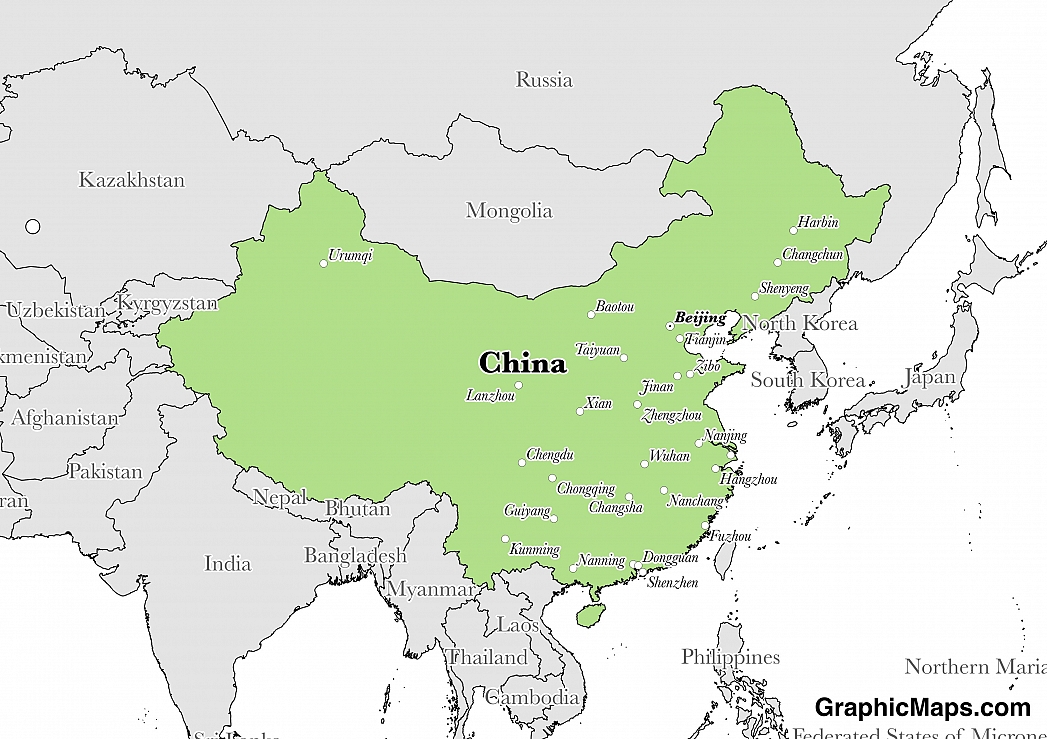Where is China?
Located in Eastern Asia, China has a 22,457.00 km border with Afghanistan (91 km), Bhutan (477 km), Burma (2,129 km), India (2,659 km), Kazakhstan (1,765 km), North Korea (1,352 km), Kyrgyzstan (1,063 km), Laos (475 km), Mongolia (4,630 km), Nepal (1,389 km), Pakistan (438 km), Russia (northeast) (4,133 km), Russia (northwest) (46 km), Tajikistan (477 km) and Vietnam (1,297 km). It has a 14,500.00 km coastline. Continuing talks and confidence-building measures work toward reducing tensions over the disputed territory of Kashmir. Boundary disputes also exist between China and Bhutan.
Beijing is located in Northern China and has a rich cultural history having been established in the year 1046 BC. The population is mostly ( approximately 95%) ethnic Han Chinese and the population of Beijing's urban areas is second only to that of Shanghai. Few cities have served as long as the political centre of a country as Beijing has. Among the modernisation, Beijing also houses several ancient attractions and sites such as temples, art, museums, and even a section of the Great Wall of China. There has been a significant explosion of population growth in the city since 1990 which has seen the population grow to over 21 million citizens.
Read more on China's CapitalChina is an Asian country covering 9,596,960.00 km2 of which 2.82% is water and 9,326,410.00 km2 is land. This makes it the 4th largest country in the world and slightly smaller than the US. Its geographic coordinates are 35 00 N, 105 00 E and Beijing is the capital city.
The English name "China" comes from the Qin (Chin) rulers who were active in the 3rd century.
Its ISO code is CN.
Geography
China has a mean elevation of 1,840 m above sea level.
It has an extremely varied climate, from tropical in the south to subarctic in the north. its terrain is mostly made up of mountains, with deserts in the west and deltas and hills in the east.
Population
China has a population of 1,373,541,278 making it the largest in the world. The majority of the country lives in the eastern half of the country.
Standard Chinese (Mandarin), Cantonese, Shanghainese are the most common languages spoken. The majority ethnic group is Han Chinese. Buddhism, Christianity, and folk religions are all practiced in China.
Although China is one of the most diverse countries in the world when it comes to languages, the majority of people (approximately 70%) in the country speak a variety of Mandarin. There is seven main dialects within the Chinese language, and they are Mandarin, Cantonese, Hakka, Wu, Min, Xiang, and Gan. Most of these languages could be considered minority languages when compared to the amount of Mandarin speakers in the country.
Read more on China's LanguagesThe dialing code for the country is 86.
Government
China is an independent country. It became the People's Republic of China in 1949. Its constitution was last ratified in 2004.
The government of China is based on a system in which elected officials from lower levels of government elect the people who take on the various roles in higher offices of the state. The local People's Congress is the only directly elected authority (by the people) in the country, and they have the right to select mayors, leaders, and heads of towns or districts. Xi Jinping is the current President of China and has held office since November of 2012. He also holds other prominent positions within the government of China, and this has led to a more centralised power structure within the nation. The parliament of Beijing is the largest in the world with over 2,900 members making up the National People's Congress.
Read more on China's GovernmentEconomy
Factoring in Purchasing Power Parity, China's GDP is $21,100,000,000,000.00 (USD) with $14,600.00 (USD) per capita. This makes it the largest economy and its citizens the 108th richest in the world. The currency of China is the Yuan Renminbi (CNY).
Its major export partners are the United States, Hong Kong, and Japan. Its main exports are electrical and other machinery. Its major import partners are South Korea, the United States, and Japan. Its major imports include electrical and other machinery, oil and mineral fuels, and nuclear reactors and boilers.
Flag
The flag of China is known as the five-star red flag and has been in use since 1949 after a successful communist revolution in China. A request for flag designs was made by the Communist Party through newspapers, and they received over 3,000 drawings, eventually choosing the five-star red flag as their new national flag. Zeng Liangsong, a patriotic Chinese citizen, created this design during 1949 and found it hard to believe his design was chosen. The Chinese flag is one of the most recognizable in the world, utilizing a bold color scheme with a symbolic and straightforward design. The red in this flag represents communism, and the golden stars symbolize the unity of the Chinese people. Furthermore, the four smaller stars are symbols for the different classes within Chinese society.
Read more on China's FlagThis page was last modified on January 17th, 2018
More on Graphicmaps

Published on 2019-11-06
What is a Trade Embargo?

Published on 2019-11-04
Which Two Countries Used to Have the Same Flag?

Published on 2019-09-16
What Is the Only Two-Sided State Flag?

Published on 2019-09-16
Which Country Flag Looks Like the Texas Flag?

Published on 2019-08-29
Flags That Resemble the US Flag

Published on 2019-08-20
